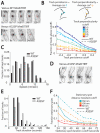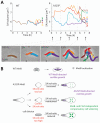A Caulobacter MreB mutant with irregular cell shape exhibits compensatory widening to maintain a preferred surface area to volume ratio
- PMID: 25266768
- PMCID: PMC4379118
- DOI: 10.1111/mmi.12811
A Caulobacter MreB mutant with irregular cell shape exhibits compensatory widening to maintain a preferred surface area to volume ratio
Abstract
Rod-shaped bacteria typically elongate at a uniform width. To investigate the genetic and physiological determinants involved in this process, we studied a mutation in the morphogenetic protein MreB in Caulobacter crescentus that gives rise to cells with a variable-width phenotype, where cells have regions that are both thinner and wider than wild-type. During growth, individual cells develop a balance of wide and thin regions, and mutant MreB dynamically localizes to poles and thin regions. Surprisingly, the surface area to volume ratio of these irregularly shaped cells is, on average, very similar to wild-type. We propose that, while mutant MreB localizes to thin regions and promotes rod-like growth there, wide regions develop as a compensatory mechanism, allowing cells to maintain a wild-type-like surface area to volume ratio. To support this model, we have shown that cell widening is abrogated in growth conditions that promote higher surface area to volume ratios, and we have observed individual cells with high ratios return to wild-type levels over several hours by developing wide regions, suggesting that compensation can take place at the level of individual cells.
© 2014 The Authors. Molecular Microbiology published by John Wiley & Sons Ltd.
Figures








Similar articles
-
MreB drives de novo rod morphogenesis in Caulobacter crescentus via remodeling of the cell wall.J Bacteriol. 2010 Mar;192(6):1671-84. doi: 10.1128/JB.01311-09. Epub 2009 Dec 18. J Bacteriol. 2010. PMID: 20023035 Free PMC article.
-
Exclusion of assembled MreB by anionic phospholipids at cell poles confers cell polarity for bidirectional growth.Mol Microbiol. 2017 May;104(3):472-486. doi: 10.1111/mmi.13639. Epub 2017 Feb 24. Mol Microbiol. 2017. PMID: 28164388
-
Mutations in the nucleotide binding pocket of MreB can alter cell curvature and polar morphology in Caulobacter.Mol Microbiol. 2011 Jul;81(2):368-94. doi: 10.1111/j.1365-2958.2011.07698.x. Epub 2011 May 26. Mol Microbiol. 2011. PMID: 21564339 Free PMC article.
-
Polar localization of MreB actin is inhibited by anionic phospholipids in the rod-shaped bacterium Escherichia coli.Curr Genet. 2017 Oct;63(5):845-848. doi: 10.1007/s00294-017-0696-5. Epub 2017 Apr 24. Curr Genet. 2017. PMID: 28439631 Review.
-
[Regulation of determination of bacterial shape].Nihon Saikingaku Zasshi. 2014;69(4):557-64. doi: 10.3412/jsb.69.557. Nihon Saikingaku Zasshi. 2014. PMID: 25447981 Review. Japanese.
Cited by
-
Cytological analysis and structural quantification of FtsZ1-2 and FtsZ2-1 network characteristics in Physcomitrella patens.Sci Rep. 2018 Jul 24;8(1):11165. doi: 10.1038/s41598-018-29284-y. Sci Rep. 2018. PMID: 30042487 Free PMC article.
-
Recent advances in understanding how rod-like bacteria stably maintain their cell shapes.F1000Res. 2018 Feb 28;7:241. doi: 10.12688/f1000research.12663.1. eCollection 2018. F1000Res. 2018. PMID: 29560261 Free PMC article. Review.
-
Cytoskeletal Proteins in Caulobacter crescentus: Spatial Orchestrators of Cell Cycle Progression, Development, and Cell Shape.Subcell Biochem. 2017;84:103-137. doi: 10.1007/978-3-319-53047-5_4. Subcell Biochem. 2017. PMID: 28500524 Free PMC article. Review.
-
Effects of antibiotics on bacterial cell morphology and their physiological origins.Biochem Soc Trans. 2022 Oct 31;50(5):1269-1279. doi: 10.1042/BST20210894. Biochem Soc Trans. 2022. PMID: 36093840 Free PMC article. Review.
-
Bacterial Filament Systems: Toward Understanding Their Emergent Behavior and Cellular Functions.J Biol Chem. 2015 Jul 10;290(28):17181-9. doi: 10.1074/jbc.R115.637876. Epub 2015 May 8. J Biol Chem. 2015. PMID: 25957405 Free PMC article. Review.
References
-
- Aaron M, Charbon G, Lam H, Schwarz H, Vollmer W, Jacobs-Wagner C. The tubulin homologue FtsZ contributes to cell elongation by guiding cell wall precursor synthesis in Caulobacter crescentus. Mol Microbiol. 2007;64:938–952. - PubMed
-
- Cabeen MT, Jacobs-Wagner C. Bacterial cell shape. Nat Rev Micro. 2005;3:601–610. - PubMed
-
- Carballido-López R, Formstone A, Li Y, Ehrlich SD, Noirot P, Errington J. Actin homolog MreBH governs cell morphogenesis by localization of the cell wall hydrolase LytE. Dev Cell. 2006;11:399–409. - PubMed
Grants and funding
LinkOut - more resources
Full Text Sources
Other Literature Sources

